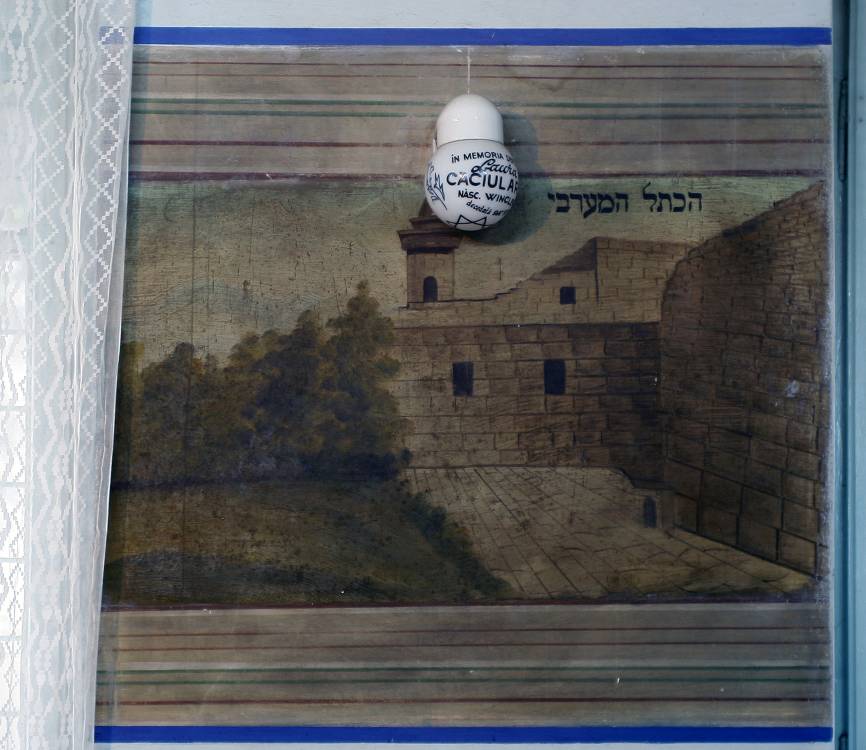Introduction. Non-Travel to a Never-Seen Land
Center and Periphery
From the West to the East and Back
Expanding the Settings
“With Eyes toward Zion”
Conclusions. Jerusalem of Romania
List of Figures
Introduction. Non-Travel to a Never-Seen Land
An extraordinarily rich variety of images of the Holy Land is found in the 19th- and 20th-century synagogues of Romanian Moldavia, the historical region between the eastern Carpathians and the Prut River.1 Persons frequenting these synagogues were surrounded by schematic depictions or naturalistic vista of that remote land in the murals and on hand-drawn Shiviti tablets produced by local craftsmen, as well as on the printed plates imported from Europe – mainly Austro-Hungary – or from the Holy Land.2 The scope of representation varied from specific buildings and sites to townscapes and geographic maps. The repertoire included Jewish historical loci sancti, graves of biblical personages and famous rabbis, various sites of traditional Jewish veneration and pilgrimage, as well as contemporaneous Jewish architecture in Jerusalem.
The Jewish culture of Moldavia in the 19th and early 20th centuries was to a significant extent shaped by the waves of immigration of Polish and Ukrainian Jews. The Romanian government did not prevent the influx of Jews to the country, but maintained a close-fisted policy concerning granting them civil rights.3 Most of the Moldavian Orthodox Jews maintained family, religious, and professional ties with their affined communities: they spoke Yiddish, shared the Ashkenazi or Hassidic rite,4 and followed the tradition of decorating the prayer hall with paintings – including depictions of the Holy Land – that developed in Polish and Ukrainian synagogues from the 18th century on.5 Almost all these people had never visited the Holy Land.
This article pursues the image of the Holy Land and the paths of a mental journey suggested by the pictorial settings of synagogue interiors in Romanian Moldavia. It is possible to find here the greatest known bulk of fortunately surviving or documented synagogue paintings of the Holy Land;6 thus an investigation of these artifacts, curious in themselves, may also compensate for the scarce data on this genre in Jewish popular art in other areas.
BACK
Center and Periphery
The Midrashim [Jewish homiletic legends] relating the Holy Land to the universe as the iris to the eye7 or the navel to the body,8 denote a hierarchy of sanctities culminating in the place of invisible God’s presence above the Holy Ark in the Holy of the Holies and the Foundation Stone in the most sacred chamber in the Temple in Jerusalem, and consequently reduced in the surrounding circles of Jerusalem and the Holy Land.9 The postulate of the incessant divine presence above the western wall of the destructed Temple10 reaffirms the supreme holiness of this area throughout the ages. In Jewish religious thought, liturgy, and customs, the entire Holy Land is considered sacred since it has become a venue of biblical history and the land chosen by God for the People of Israel; it continues to be a ritually holy place and messianic refuge for the faithful.11
The Jewish liturgy substantiates this concentric concept by demanding of the worshiper praying in the Diaspora to face towards the Holy Land and in the Holy Land towards Jerusalem; those who pray in Jerusalem face towards the Temple Mount; and those who pray at the Temple Mount turn their faces towards the chamber of the Holy of Holies, from which the prayer arises to God’ celestial throne.12 European Jews considered the Holy Land as laying to the east and oriented their synagogues either eastward or, geographically more correctly, southeastward. The Torah ark was set in the eastern wall of synagogues and its design often alluded to the Ark of the Covenant and the Temple.
Seemingly a contradiction to this topography, a few of the earliest representations of the urban settings around the Temple are located on the western side of the synagogue interior. They are schematic depictions of Jerusalem with a domed edifice in its midst – obviously, the Temple13 – painted by Eliezer Sussman of Brody in several synagogues in southern Germany between 1732 and 1742. Iris Fishof related the placement of these views on the western side of synagogues to the kabbalistic reading of the name of Jerusalem as a synonym for the lowest of the ten sephirot [stages of divine emanation] that is associated with the west in Pardes Rimonim [Orchard of Pomegranates] by Moses ben Jacob Cordovero of Safed (1522–70) printed in Cracow in 1592. Jerusalem and the Temple were reasserted as the first two of eighteenth stations in the heavenly ascent of Jewish prayer in Seder Sha‘ar ha-Shamayim [Order of the Gate of Heaven] published in Amsterdam in 1717 by a follower of Safedian kabbalah, Isaiah Horowitz (ca. 1565–1630).14
An infrequent location of an image of Jerusalem on the western wall in Romanian synagogues is found in the wooden Hassidic synagogue (the so-called Ba‘al Shem Tov Synagogue) in Piatra-Neamţ.15 The mural in a trompe-l’œil frame, captioned in Hebrew “Jerusalem; The Temple,” portrays a cityscape dominated by the Dome of the Rock.16 The image appears between two doors in the center of the western wall of the synagogue’s prayer hall. This well observable section in the only plain, plastered wall in the room was the best practical solution for locating a large painting. Yet, we have no enough evidence to state whether, while making this choice, the anonymous artist or his Hassidic patrons also followed the kabbalistic concept of a more meandering path of prayer that departs the synagogue from the side opposite the Torah ark.
In the Temple-centered world image, the wider circle of sacredness embraces the Holy Land, which in Jewish minds is perceived sacred since it has been chosen by God to serve as a venue of biblical events, as well as the historical home and eschatological refuge for the People of Israel. Over and above the gradual scale of sacredness within its central area, the Jewish centrifugal topography is distinctly dichotomic: even after the destruction of the Temple the entire Holy Land continues to be a ritually sacred realm17 and the omphalos mundi, while its periphery is a profane domain18 where generations of Jews sojourn in expectation of their return to the Godly promised homeland. To the best of our knowledge, this concept was first elaborated in synagogue art around the years when Eliezer Sussman depicted Jerusalem in German synagogues. A stylized imaginary urban view labeled ירושלים עיר הקודש (the Holy City of Jerusalem) that resembles Sussman’s paintings was produced by Hayim ben Isaac Segal of Slutzk in the so-called “Cold” wooden synagogue in Mogilev on the Dnieper in 1740. Unlike Sussman, Segal placed his Jerusalem on the side closer to the Torah ark, in the southeastern section of the cupola, and complemented it with a similar representation of a town inscribed in Yiddish ווירמש (Worms) in the northeastern section.
Rachel Wischnitzer proposed that Hayim Segal derived his subject from the medieval Jewish folklore recorded by a beadle of the synagogue in Worms on the Rhine, Juspa (Jephthakh Joseph ben Naphtali, ca. 1604–78), in his book Ma‘aseh nissim [Story of Wonders] in the 1660s,19 as it might have been known to Segal from either hearsay or earlier publications of Juspa’s book.20 A legend asserts the establishment of the Jewish community of Worms by a group of Judean exiles from the Holy Land after the destruction of the First Temple in Jerusalem, who fled here instead of to Babylon. When the Jews in Babylon were redeemed and resettled in the Holy Land, the Jews of Worms did not leave the Diaspora, arguing that Worms had become their comfortable home and a “lesser Jerusalem”. The story concludes: “For these reasons they [the Jews of Worms] were visited by harsh persecution, and other communities were punished because of Worms.”21 The tale treats the town as a twofold symbol: first, it appears to be a kind of European Babylon, an archetypical figure of Jewish exile; secondly, it is a quasi-Jerusalem contesting the holiness of the true Holy City. In his painting, Hayim Segal condemns the inversion of the world’s order of holiness by the Jews of Worms by adding before the town walls the figure of a terrifying dragon, which obviously acts as an agent of divine anger punishing the heretics.22
The Jerusalem-Worms contraposition in synagogue art is known to us as Hayim Segal’s exclusive innovation.23 Much more frequent in east-European synagogue art were expressions of the antithesis ‘Jerusalem versus Babylon’ implied by depictions of musical instruments hanging on trees by the rivers of Babylon, as chanted in Psalm 137:1–3, and in the background of some of these images appears a cityscape. An early known specimen of this iconography was produced ca. 1760 in the synagogue of Przedbórz on Pilica in Poland (Fig. 1). Rendered in a more volumetric style than Eliezer Sussman’s and Hayim Segal’s flattened cityscapes, the painting of a city seen through a fence of trees and suspended instruments in the Przedbórz synagogue replicates a similar urban architecture. A hint for the identification of the city seems to be a domed tall building rising high above the skyline that may be associated with Babylon’s fabulous landmark – the Tower.
A more conventional representation of the Tower of Babylon as a ziggurat-like stepped edifice is seen next to the trees with musical instruments and opposite a town at a riverside in Babylon in a painting in the early-19th century synagogue of Grójec. The town’s storeyed buildings, resembling native architecture, reinforce the association of Babylon with Europe. The only known wider view of this side of the synagogue’s interior captures one more painted panel placed symmetrically to the picture of Babylon; it seems that the other image depicts an architectural object. Maria and Kazimierz Piechotka reasonably considered it to be the Temple in Jerusalem, but the photograph is too blurred to discern this object clearly.24
In early-20th century synagogue paintings, the depictions of musical instruments which the Jews in the Babylonian abstained from playing as a gesture of their mourning for Zion, became a common complement to the images of Jerusalem. In Moldavia, the concept of the Babylonian exile and redemption in the Holy Land was spectacularly implemented by Mendel Grinberg of Iaşi (d. 1928), who decorated dozens of synagogues in the region. On the northern wall in the Grain Merchants’ Synagogue in Bacău Bacău, he painted the instruments on trees against a sunset and inscribed the panel in Hebrew “Upon the willows in the midst thereof we hanged up our harps” (Psalms 137:2; Fig. 2). On the southern side of the hall, he depicted the Dome of the Rock in Jerusalem and captioned it, “The Holies [sic!] of Holies with the Foundation Stone” (Fig. 3). The two large facing paintings are prominently distinguished among the numerous murals in the prayer hall: the views of Babylonia and the Holy Land appear in the center of a wall and are framed by naturalistically painted theatrical red curtains. This scenery on either side of the synagogue worshippers might evoke in them a sense of existence in transition from the past and present exile to future redemption, from routine to miracle, and from profane to holy.
The emphasis placed on this pair of paintings in the synagogue interior is reinforced by the artist’s signature in the top of each of them. Above the local paysage standing for the “rivers of Babylon” Mendel Grinberg advertizes himself in Romanian as a pictor decorator and provides the address of his workshop in Iaşi. He uncustomarily spells his family name “Grünberg” (with the u-umlaut as the first vowel), perhaps purporting his reputation as a master of a prestigious foreign, German or Austro-Hungarian mode of decorative painting.25 In contrast, the text in Hebrew and Yiddish above the vista of Jerusalem is the dedication of a Jew who devotes his skills to glorifying the place of Godly worship.26 Now the artist omits his family name, but expands his given name to its full form that is used mainly on ritual and commemorative occasions.27 Although loosely observing religious laws in his everyday life, when painting in a synagogue he introduced himself by a quotation in Hebrew from Isaiah’s prophesy, “the work of my hands, wherein I glory” that implies his association with God’s righteous people, who “shall inherit the [Holy] Land for ever” (60:21). The difference between the Romanian and Jewish versions testifies to the duality of Grinberg’s self-identity, European and Jewish, and to his dual attitude to art as both livelihood and mission. Thus the artist’s signatures personalized the message of the images they embellish.
The point of view at the Holy Land is moved further to the periphery in the early-20th-century painting “Upon the willows…” by an anonymous artist in the Great Synagogue of Iaşi (Fig. 5). The trees with musical instruments hanging from their branches near a row of domed buildings represent Babylon. A book with musical notation cast down before the trees demonstrates that the Jews abstained from singing “the Lord’s song in a foreign land” (Psalms 137:4), for it is Jerusalem that they set above their “chiefest joy” (Psalms 137:6). A conventional sign for the Temple’s site in Jerusalem, the Dome of the Rock is prominently shown in a deeper plane.28 The painting renders Babylonia as the side from which the Jewish beholder in Romania observes the heart of the Holy Land. The romantic-national perception of the Holy Land as a distant vision seen by the beholder in the Diaspora was well familiar to a wide stratum of Jews through the works by Ephraim Moses Lilien (1874–1925), beginning with his illustration of “Der Jüdische Mai” in 1902.29
Focusing on the development of one kind of Holy Land images, the above survey epitomizes as well that despite the peripheral location of Moldavian Jewry on the geographic map of the Ashkenazi Diaspora and the lack of evidence about their synagogue art prior to the early 19th century, by the later years of that century Moldavian synagogues had become a lively center of artistic experiments in visual representation of the Holy Land.
BACK
From the West to the East and Back
In the late 19th century, relatively cheap printed broadsheets brought to Moldavian Jews representations of the Holy Land as an entity composed of towns, biblical sites, and graves. A colour lithograph showing sacred places of the Holy Land around a view of Jerusalem signed by Saul ben Pinkhas Hornstein of Vienna and dated 1888-89 was displayed in the bet-midrash (house of study used also as a synagogue) on Suliţa Road in Botoşani (Fig. 6). The origin of East-oriented maps of the biblical Promised Land shown above the Mediterranean Sea is traced back to the late-16th- and early-17th-century Netherlands.30 A Dutch printed pictorial map dated ca. 163031 was reworked for the Hebrew reader in Abraham bar Jacob’s edition of the Passover Haggadah (Amsterdam, 1695) and reproduced in numerous later reprints.32 The map delineates the route of the Exodus and its destination – the Promised Land with the tribal allotments of Israel. The cartographer depicted a single or a few grouped buildings to denote inhabited places, covered the land with numerous hills and trees, and mirror-copied a ship in the sea from his Dutch model. This folded inset in the Haggadah could facilitate a mental participation of its reader in the legendary journey of the People of Israel.
In the late 1830s, Abraham bar Jacob’s map was reworked by Jewish folk painters in the Holy Land into panoramic maps composed of greater images of Jerusalem and Safed shown against strips of cityscapes and countryside. The earliest known work of this type was drawn by Hayim Solomon Luria of Tiberias as an offering to solicit aid for the victims of the 1837 earthquake in Galilee.33 Numerous later versions were produced in various media in the Ottoman Empire, Austro-Hungary, Germany, and Poland. Some of them were designed as a Shiviti, decorative plaque inscribed with the Hebrew verse “I have set (shiviti) the Lord always before me” (Psalms 16:8), usually placed above the cantor’s pulpit in synagogues.34
A similar map attributed to Hayim Solomon Pinia of Safed (Fig. 7)35 served as a model for the lithographic “Panorama des heiligen Landes” [Panorama of the Holy Land] with inscriptions in German and Hebrew printed by M. Munk in Vienna, 1875. Hayim Solomon copied the location of vestiges of biblical times, but omitted the route of the Exodus, the tribal partition of the land, and some biblical towns that no longer existed in his days. Instead, he added many later settlements, and graves of post-biblical sages and modern rabbis.36 The expanded range of sacred objects and sites and alignment of the panoramic views to strips were most likely inspired by the rows or columns of patterns depicting or symbolizing the sacred places in illuminated itineraries and single-sheet charts of the Holy Land produced by Jewish scribes and folk artists in Jerusalem and Safed in earlier times.37
Munk’s “Panorama” was distributed in inexpensive, large lithographic prints (49.7 x 69.9 cm) on paper or cloth that were obviously used to decorate walls in Jewish middle-class homes, where the beholders could scan the map level by level while consulting the inscriptions, tracing the routes across the Holy Land, and concentrating on its famous places. Although located off center, the image of Jerusalem nevertheless dominates the map due to its scale, unproportionally large in relation to the other towns. The entire center of Jerusalem is occupied by the frontally shown Western Wall. Rising above the Wall, an enormous round tower with a pendentive dome and attached minaret represents the Dome of the Rock labeled “Türkische Moschee” and “Al Charim” (after Arabic Haram al-Sharif, the Noble Sanctuary). The significance of this structure for the Jews is explained in Hebrew:מקום קדש הקדשים [the place of the Holy of Holies] and in German: “An diesem Orte war einst das Allerheiligste des Tempels.” Those who ponder the two Hebrew quotations from the Bible running along the map’s lower border38 convert the image of both historic and contemporary Holy Land into a symbol of remembrance of Jerusalem by the Jews in Exile and their hope for messianic Redemption.
Another combination of the pictorial representation and topographic mapping of a land was crafted by Yehosef Schwarz (1804–65), a Bavaria-born Jewish cartographer and graphic artist, who in 1833 immigrated to the Holy Land. In 1836/37, Schwarz published his first lithographic panorama, oriented to the east, comprising a view of the Temple Mount and the Western Wall within the greater central panel and – on either side – smaller frames showing sacred places in Jerusalem. The entire layout, resembling an exposition of framed paintings on a wall, invites the beholder to scrutinize the holiest area of Jerusalem, then to complement his or her impression by examining the sacred places in the vicinity and to note an approximate correspondence of the mutual location of the images of sites to their geographic location marked on the map of Jerusalem appearing at the top of the print. Schwarz’s work dedicated to “the brethren sitting in the Exile and seeking for Zion and Jerusalem”39 exemplifies what the pictorial model from the Holy Land underwent in the Diaspora: his tonal lithograph was redesigned in Europe in a simpler linear style. An exemplar of this replica (Fig. 8) reached Austrian Galicia and then passed to Romania.40
In his lithograph published in the printing house of E. M. Joachim in Vienna in 1888-89 (Fig. 6), Saul ben Pinkhas Hornstein had fragmented a panoramic map of the Holy Land into framed pictures, which he incorporated into a Mizrakh plaque indicating the direction of prayer in Jewish homes. This function is designated by the Hebrew definition MiZRaKH (East) written twice as an initial world and repeated once again as an acrostic Mi-tzad Ze Ruakh KHayim (At this side is the spirit of life) in the upper section of the print. Hornstein apparently based his work on the “Panorama des heiligen Landes” published in the same city of Vienna about fourteen years earlier. He reproduced a section of the coastal strip from Sidon on the north to Jaffa on the south within the arcade in the bottom center. In the middle of the plaque, he thoroughly copied the depiction of Jerusalem with its densely built quarters surrounding the Western Wall and the Dome of the Rock and its pendentive dome and minaret, now bearing a flag with the Turkish crescent.
Hornstein’s noticeable alterations to his model are, first, the relocation of the caption “Jerusalem” into the center, and, secondly, the addition of another domed building with a minaret at the right side of the Western Wall, symmetrical to the Dome of the Rock. As a result, he distinctly accented the holiest area of the Temple Mount and brought the entire map into closer accordance with the concept of the direction of prayer ascending to heaven via the Holy Land, Jerusalem, and the Temple. The quotation from 1 Kings 8:4841 inscribed within the white banderole just under the image of Jerusalem reiterates this idea; other excerpts from the Bible embedded in the Mizrakh bless the worshippers42 and affirm their historical and spiritual ties to Jerusalem.43 The sight of a worshipper directing the prayer eastwards while facing the Mizrakh thus grasps the earthly destination of the prayer: the picture furnishes a backdrop for a spectacle of an imaginary ‘tunnel in space’ from the Diaspora to the Holy Land.
Copies, imitations, and releases in various media and at different levels of professional execution were a common way of disperse of printed models in Jewish popular visual culture. Unlike the peculiar image of the Dome of the Rock in the Viennese “Panorama” and Mizrakh (Figs. 6–7), a faceted building bearing a domed drum and embraced by a square-plan wall, probably a derivative from Yehosef Schwarz’s images (Fig. 8), stands for this edifice in a version of Hornstein’s lithograph in the Suliţa bet-midrash in Botoşani (Fig. 6). This and several other alterations, as well as a more naïve rendering of the images, decoration, and script suggest that this print is an imitation of Hornstein’s work.44
The exchange of images and ideas regarding the representation of the sacred places between the European Diaspora and Jewish settlement in the Holy Land lasted for ages: influenced by even earlier European models, the pictorial maps imported from 19th-century Jerusalem, Safed, or Tiberias were copied in Austro-Hungary, Germany, or Poland. One more turn of copying of the European-made panoramas in the Holy Land for their export to Europe followed the establishment of the Monsohn lithographic printing house in Jerusalem in 1892.45 For example, the general composition of Hornstein’s Mizrakh was re-implemented in a lithograph presumably printed in the Holy Land in the 1920s (Fig. 9), an exemplar of which was found in the Furriers’ Synagogue in Piatra Neamţ (Fig. 10).
BACK
Expanding the Settings
The experience of observing the images of the sacral places while mentioning them in prayer was obviously so impressive that the patrons of the Suliţa bet midrash in Botoşani and the Furriers’ Synagogue in Piatra Neamţ chose to share it with their fellow congregants by mounting Mizrakh prints on the cantor’s pulpit in the locale traditionally reserved for the Shiviti (Figs. 6 and 10).46 Yet, since Mizrakh plates and pictorial maps are designed for private use, while their contents are legible enough to anybody approaching the plate hung on a wall or the map spread on a desktop, they are barely discernible by the attendees of synagogue services standing behind the cantor whilst the latter is facing the Mizrakh on his pulpit.
For synagogue painters, the panoramic maps and pictorial Mizrakh plates were easily available and portable pattern-sheets that were considered as a trustworthy source of what the Holy Land looks like. In late-19th-century Romanian Moldavia, the images of the Holy Land made their way from prints to synagogue walls. Of the numerous wall paintings modeled on prints, only several representative examples are mentioned below due to the limits of space. A mural in the Khesed shel Emet [An act of true kindness] Burial Society’s Synagogue of Radauţi (Fig. 11) accurately quotes the depiction of Jerusalem in the “Panorama des heiligen Landes” (Fig. 7). In the corporative synagogues of Jewish tailors and furriers in Piatra Neamţ, the pictures of Hornstein’s Mizrakh served as the model for the painted wall panels of Jerusalem (Fig. 6, the central panel; and Fig. 11); Mount Carmel; tombs of Rachel near Bethlehem, Prophet Samuel near Jerusalem, Meir Ba‘al Ha-Nes near Tiberias (Fig. 6, to the left of the menorah; and Fig. 13), and Joseph in Shechem. The painter of the Furriers’ synagogue also possessed an imprint of the Mizrakh of the 1920s from the Holy Land, from which he copied the “Place of the Temple” (Fig. 9, the uppermost panel in the right column; and Fig. 14).
By the 1930s, a few dozens places in the Holy Land were depicted in Moldavian synagogues after the samples that, in addition to the broadsheet maps and ritual plaques, included more kinds of prints of either Jewish or Christian provenance: postcards, photographs, illustrated periodicals, and books. For instance, Mendel Grinberg’s “The Holies of Holies with the Foundation Stone” in Bacău (Fig. 3) is an enlarged and vividly coloured replica of “Mosque of Omar” (Fig. 4), one of the pocket-size chromolithographs (7.5x12 cm each) in the set “Souvenir de Jérusalem” printed by a Christian shop-keeper in the Old City of Jerusalem, Boulos Meo, ca. 1880. Another plate of Meo’s set, “The Tower of David,”47 was reproduced in the Leipziger Temple (also known as the Great Synagogue) in Piatra Neamţ around 1930.
The wall paintings in the Leipziger Temple of Piatra Neamţ (Fig. 15) and numerous similarly decorated synagogues elsewhere in Romanian Moldavia turn the prayer hall into a gallery of illusory canvas paintings or pictorial panels. In terms of formal composition, the translation of a network of framed landscapes in Mizrakh plates into individual paintings within trompe-l’œil frames hung on a rope from a hook in the wall was a further step in the process, commenced by Yehosef Schwarz in Jerusalem and Saul Hornstein in Vienna, of the fragmentation of pictorial maps into separate representations of particular views. Whereas the printed panoramas suit the field of vision of a static bystander, the paintings surrounding the prayer hall demand of their spectator to move in space. The expanded setting of pictorial vistas enriched the feeling of one’s sight penetrating from Romania through the Holy Land to the heart of Jerusalem with the impression of travelling across the Land: when looking at the pictures around them on synagogues walls, the worshippers could feel themselves as if making a pilgrimage to the holy places.
BACK
“With Eyes toward Zion”
The perception of the Holy Land discussed above as circles of sacred places surrounding Jerusalem fails to explain the earliest known series of landscape murals in the Moldavian synagogues that have survived in the vault of the Great Synagogue of Botoşani.48 The anonymous artist incorporated the landscapes as well as the symbols of the Zodiac and allegoric animals in two rows of painted panels running along the vault’s bottom (Figs. 16–17), and depicted one more cityscape, now repainted, on the western wall (Fig. 18).49 The groups of domed buildings and tall turrets among sparse rows of trees lining the skyline and sloped hills reiterating in these landscapes are inspired by M. Munk’s edition of “Panorama des heiligen Landes” (Fig. 7). For example, a panel at the southern section of the vault’s western side (Fig. 16) copies the view of Bethlehem shown to the right of Jerusalem in the “Panorama” while the panel next to “Bethlehem” in the synagogue vault duplicates the Mount of Zion appearing above Bethlehem in the map. The rest of the landscapes in the BotoÅŸani synagogue are modeled more or less precisely after other details of the “Panorama.” Consequently, the year of publication of this map, 1875, provides the terminus a quo for the synagogue paintings.
When comprehending these landscapes in the context of synagogue liturgy, the congregation might readily associate the seemingly oriental architecture with the Holy Land. However, they could barely recognize any featured religious, historical, or geographic objects and sites, all but one of which bear no inscription. The only caption under a landscape in the vault – כפר בּירייט [village of Biryat] (Fig. 17) – corresponds to no place known to us in the Holy Land, but is almost identical with of the name כפר בירייא [village of Birya] in the “Panorama” (Fig. 7, the leftmost inscription in the first strip from top in the upper left section). The synagogue painter probably confused the letter א (aleph) at the end of “Birya” written on the map in the so-called Rashi script with the square-script ט (tet) like that he drew at the end of “Biryat”. A group of buildings and trees, and a hill that represents Birya in the panoramic map could serve as a model for the image of “Biryat” in the synagogue painting. A few legendary graves50 in the vicinity of Birya near Safed, once home to Jewish sages and in the 19th century a small Arab village,51 were the object of Jewish pilgrimage; but with the exception of Botoşani, Birya does not appear in synagogue decoration.
An assumed reading of כפר בּירייט (village of Biryat) as misspelled בירות (Beirut)52 seems to be unconvincing for the city of Beirut would scarcely be defined ‘village’. The synagogue painter would have seen the proper spelling of the title “Beirut” in Hebrew and German far down of “Village of Birya” in “Panorama des heiligen Landes,” above a dense front of storeyed towers with low cupolas, fenestrated houses, turrets, and flags waving on poles (Fig. 7, the lower left corner). A similar view appeared in the Botoşani synagogue in the only cityscape painted on the wall (Fig. 17). In spite of our expectations to meet Jerusalem in such a prominent location, this image has little in common with the traditional representations of the Holy City focusing on the Western Wall and the Dome of the Rock. The depiction of Beirut had its precedents in Jewish maps and panoramas. It was introduced there by Galilean Jewish cartographers53 and had survived in this art long after it was painted in Botoşani: Beirut is even defined in Hebrew as “the Holy City” in the Mizrakh from Jerusalem dated to the 1920s (Fig. 9); yet, no image of Beirut is known to us in the other synagogues.
In seems that the peculiar emphasis on Birya and Beirut as well as representation of the rest of the cityscapes as generic in the Great Synagogue of Botoşani reflect the changes in the Jewish perception of the Holy Land during the second half of the 19th century.54 In mid-century, Israel Joseph Benjamin of Fălticeni (1818–64), who set out in the wake of medieval Jewish travellers to find the lost Ten Tribes of Israel,55 came back from the Holy Land with considerations regarding the development of its agricultural colonization.56 Such dreams yielded the first attempts of Jewish emigration from Romania to the Holy Land in the 1870s. In the early 1880s, the ties between the Jews in Romania and Jewish communities in Galilee strengthened due to the visit in Romania of a charismatic champion of Jewish agrarian labour and founder of the Holy Land Settlement Society in Safed, Eliezer Rokah (1854–1914). He propagated for immigration to Palestine in Romanian Jewish communities and disseminated his ideas through Hebrew and Yiddish periodicals in Romania and far beyond. The Holy Land Settlement associations and Hovevei Zion societies in Romania, including branches in Bacău, Botoşani, Iaşi, and Piatra Neamţ, were fertile soil for the speedy spread of political Zionism that followed the publication of Theodor Herzl’s Der Judenstaat in 1896 and a translation of the book into Romanian later in the same year.57
The emphasis on the village of Birya in the paintings of the BotoÅŸani synagogue could make sense in the context of Jewish national revival in the Holy Land. Supported by the Holy Land Settlement associations in their native towns, immigrants from Romania took an active part in the establishment of new Jewish settlements in the Holy Land and especially in Galilee during the 1880s and early 1890s.58 As far as we may speculate over the scant historical evidence on these issues, the image of Birya in the synagogue of Botoşani could have commemorated some engagement of its congregation in a project of the Jewish colony in Birya around 1895, when a parcel of land was purchased there, most likely with assistance of Baron Edmond de Rothschild (1845–1934).59 The reason for a prominent display of the painting of Beirut on the synagogue wall might have been the role of this city as a principal hub connecting Romania and Galilee and headquarters for Jewish colonization activities.60
The neglect of sacred places in the wall and ceiling paintings of the Holy Land in the Botoşani synagogue had its parallel in the emergence of pragmatic overtones in the romantic religious discourse pertaining to the gathering of the dispersed people of Israel in their ancestral homeland. A group of Romanian Jews, who sought to establish an agricultural colony in the Holy Land in 1873, proclaimed that their aim was “to settle, cultivate, and preserve” the “land of the forefathers” where they would be able “to serve God freely, without harassment”. They foretold their immediate future in the eschatological terms of the resurrection of dry bones prophesied by Ezekiel (37:1–14). The tone turned to practical when they inquired about the land, which they planned to purchase for their settlement: “What is the country like: mountains and hills or rather plains; whether or not are there streams of water?”61 In contrast to the travelers for whom the country was a mere substance that fills in the gaps between the places of pilgrimage, the settlers transferred the focus from monuments onto the terrain to which they were going to entrust their lives and prosperity. The blue sky over green hills, high trees, white buildings with red roofs, and no grave depicted in the synagogue paintings in BotoÅŸani created an idyllic view of the Holy Land which was able to encourage the congregants pondering its colonization.
Desacralization of the Holy Land in the undefined landscapes of the Botoşani Great Synagogue has remained a unique local experiment: as a rule, the representations of the Holy Land in Moldavian synagogue art conveyed well recognizable and clearly captioned views of the places of religious veneration. The integration of the religious topography in the mainstream Zionist rhetoric is epitomized by Naphtali Herz Imber’s (1856–1909) Hatikvah [The Hope]. The poem first drafted in Romania ca. 1877 as Tikvatenu [Our Hope] became the anthem of Hovevei Zion and then of the Zionist movement.62 Imber enchants a sight of a Jew in exile, who gazes through tears towards “the borders of the East”63 and envisions the Holy Land. The poem guides the eye over the mirages of holy places, sacred graves, and fabulous natural landmarks, which list comprises Zion, Jerusalem (also called the “height where David dwelt”), the Holy City’s gate, Western Wall, place of the Temple’s “sacred ruin,” “fathers’ graves,” as well as the Jordan River and the Sea of Galilee.
The selection of holy places in Imber’s poetic itinerary echoed the earlier Jewish panoramic maps and anticipated the extended visions of the Holy Land in the Moldavian synagogue art of the first third of the 20th century. The painters pictured the principal holy places in Jerusalem: the Dome of the Rock marking the location of the Holy of Holies (for example, Figs. 3, 11–12, 14) and the Western Wall (for example, Figs. 23–24). In many synagogues the repertoire was expanded by the views of “Fortress of David,”64 “Zion, That Is the City of David,”65 and “Graves of Kings of King David’s Dynasty in the Holy City of Zion”66 as well as the “Wall of Jerusalem” (a city wall, not the Western Wall!),67 “Golden Gate,”68 and “Damascus Gate.”69 Attendees of Moldavian synagogues observed views of places all across the Holy Land: the cities of Safed, Tiberias at the Sea of Galilee,70 Jericho,71 and Hebron;72 the Jordan River;73 and the mounts of Carmel,74 Tabor, and Hermon.75
Landscapes became a non-figurative charade of biblical narrations that connected their heroes to particular locales in the Holy Land. In Moshke’s Synagogue in the town of Roman, a wall painting of a great tree in the midst of a fenced yard is entitled “Eshel Abraham.”76 The Bible uses the word eshel, a Hebrew term for tamarisk, for the tree planted by Abraham in Beer Sheba (Gen. 21:33). Jewish folklore identified this plant with the tree under which Abraham entertained the three angels (Gen. 18:1–4). An old oak at the Oaks at Mamre near Hebron (Gen. 13:18) was believed to be Abraham’s tree still living.77 In the Passementerie Merchants’ Synagogue in Iaşi, an image of a few houses among flourishing trees illustrates “Leah’s Tent” near the tents of heroes of the episode of stolen idols in the camp of Laban at Mount Gilboa in the Bible (Gen. 31:33).78
The Hatikvah poses the pilgrimage to the sacred graves as a ritual proving the Jewish attachment to the Holy Land: “And tens of thousands of our people go / To find the fathers’ graves again.”79 Similarly, the synagogue art largely showed the sepulchral monuments as an integral component of the gallery of Holy Land views. In addition to the tombs of Rachel, Joseph, King David and his royal successors, Prophet Samuel, and Rabbi Meir Ba‘al Ha-Nes (Fig. 13) mentioned above, there were also the “Cave of Makhpelah” with its tombs of biblical patriarchs in Hebron;80 the monuments related to Absalom, son of King David and Zechariah in the Kidron Valley;81 the burial place of Simeon (Shimon) the Just at Mount Scopus in Jerusalem;82 and the grave of Rabbi Shimon bar Yokhai in Meron near Safed.83
The visions of Jewish historical heritage were complemented with the images of two synagogues in the Old City of Jerusalem, the establishment of which symbolized a renascence of Jewish spiritual life in the Holy Land. One of them, the Hurvah Synagogue [after the Hebrew khurvah: ruin], also known as the synagogue of Rabbi Judah he-Hasid, was founded in the early 18th century, destroyed by Muslims a few years later, and rebuilt from the ruins in 1864 by the Perushim, followers of the Gaon of Vilna (Elijah ben Shlomo Zalman Kremer, 1720–97).84 The Perushim, who emigrated to the Holy Land in the early 19th century, approached the reconstruction of the Hurvah as an act heralding the rebuilding of the ruins of Jerusalem, restoration of the Temple, and messianic Redemption.85 Another synagogue, Tiferet Israel [after the Hebrew tif’eret Yisrael: glory of Israel], was inaugurated in 1872 by the Jerusalemite Hassidim.86 The large domes on paneled drums atop the Hurvah and Tiferet Israel synagogues in the Jewish Quarter were reminiscent of the Dome of the Rock. The synagogues’ high domes contesting the Dome on the Temple Mount and the Holy Sepulchre in the Christian Quarter in the skyline of the Old City also implied that the Jews were reclaiming their primogeniture in the City of God.
The images of the Hurvah and Tiferet Israel reiterated in Jewish prints, stamps, offerings and souvenirs from Jerusalem became symbols of the city’s Ashkenazi traditionalist and Hassidic communities.87 Despite the caption that refers only to the “Hurvah of Rabbi Judah he-Hasid,” a view of both synagogues is shown in the Mizrakh from Jerusalem (Fig. 9, the second frame from the top in the rightmost column).88 The juxtaposition of this picture and the view of the “Place of the Temple” marked by the Dome of the Rock that is seen just above evokes contemplations on these synagogues as precursors of the Messianic Temple. This very cityscape from the Mizrakh, with its two synagogues and the same Hebrew inscription mentioning the “Hurvah of Rabbi Judah he-Hasid,” was painted on a wall of the Furriers’ Synagogue in Piatra Neamţ (Fig. 19). Tiferet Israel was depicted alone, without the Hurvah, in Moshke’s Synagogue, presumably a Hassidic one, in Roman.89
The designation of architectural testimonies to the Jewish spiritual resurrection of the Land of Israel in Moldavian synagogue paintings embraced the projects of cultural Zionism. Envisaged by Romanian Jews in the 1870s as a “temple for wisdom and education”90 and dubbed by Zionists “the crown of our cultural work” in the 1910s,91 the Hebrew University in Jerusalem appeared in a wall painting in the Tailors’ Synagogue of Piatra Neamţ in the shape of a great central-plan domed building surmounting a hill (Fig. 20). The image closely resembles Frank Mears’ painting for Patrick Geddes’ unrealized project (begun in 1919) of the Hebrew University’s main hall.92 A painter from Piatra Neamţ had probably seen Mears’ painting in its simplified graphic copy (Fig. 21) on the cover of a booklet of postcards showing the building process of the University that was published by the Jewish National Fund in Warsaw in 1925, the year of the University’s inauguration. The apparent similarity of Geddes’ central-plan domed hall to the Dome of the Rock93 expressed his vision of two urban foci: the center of knowledge and enlightenment of New Jerusalem on Mount Scopus vis-à-vis the Old City’s sacred core on the Temple Mount. In doing so, Geddes shared the Zionist topos of the Temple in Jerusalem being rebuilt for intellectual and educative rather than ceremonial purposes.94
Assumingly, the dichotomy of secular and religious made a lesser effect on the minds of synagogue attendees in Romania, for whom the Temple-like Hebrew University would have been another marvel of contemporary redemption of the Holy Land. The same anonymous artist who depicted the Hebrew University in the Tailors’ synagogue also duplicated a postcard from Jerusalem with an image of the “Bezalel Sales Pavilion”95 in the Leipziger Temple in the same town of Piatra Neamţ (Fig. 22).96 We may guess that a view of the gallery established by the Jewish academy of arts at the foot of David’s Tower evoked in the synagogue painter an amalgam of historical allusions, national inspiration, and professional pride.
The integration of secular buildings into the gallery of holy places served the function of Romanian synagogues as a stage for Zionist propaganda. The strong emotional effect of Zionist speeches in synagogues of interwar Moldavia triggered the plot of the unfinished novel Meletie Jidovul [Meletie the Yid] by a Botoşani-born Jewish-Romanian writer, Enric Furtună (1881–1964). The protagonist of the novel, a son of synagogue cantor Meleh Rabinovici from Iaşi, converted to Christianity and adopted a Romanian name, Meletie Popescu, for the sake of his successful carrier as an advocate. Happening to be in a synagogue in his native town when an elated crowd of Jews was hearkening to a Zionist propagandist, Meletie, still called offensively jidovul [Yid], experiences a catharsis causing his spiritual transfiguration: his deep compassion to the brethren captured by the idea of national redemption causes him to return to the fold of Judaism.97 The painted decoration was both an extension and catalyst of similar coalescing religious sentiment and national enthusiasm. The kaleidoscope of historical sacred places and modern Zionist achievements displayed in synagogues would have turned such propagandist performances into showy travelogues.
BACK
Conclusions. Jerusalem of Romania
The views of the Holy Land in the synagogues of Romanian Moldavia originated in the prints, souvenirs, and ephemera that were, either truly or reputedly, physical messengers from the distant places they depicted98 and thus would have been accepted as reliable eyewitnesses. The reoccurrence of the same images in various media available to Romanian Jews not only reinforced the viewers’ sense of the reliability of the depictions of holy places, but also – using Walter Benjamin’s definition – was able “to bring things ‘closer’ spatially and humanly” and thus to overcome “the uniqueness of every reality by accepting its reproduction.”99 The process of assimilation of the remote reality in Moldavian synagogues becomes better discernible when the artists had to expand their paintings of holy places to the areas that lay beyond what they could consult in their samples.
A work of the kind is found in an auxiliary prayer hall in the vestibule of the Ba‘al Shem Tov Synagogue in Piatra Neamţ (Fig. 23). The painter reproduced an iconic image of the Western Wall receding in perspective towards a frontally shown wall of the adjacent building. Such views from a sharp angle were preferred in the realistic depictions and photographs of the Western Wall as long as the dwellings of the Moroccan Quarter bordered the narrow plaza in front of the Wall and blocked the frontal sight of the Western Wall of the kind widespread in Jewish popular art (for example, Figs. 7, 11–12). In the Ba‘al Shem Tov Synagogue, the depiction of the Western Wall in perspective took up only half of the wide panel allotted to the painting in the synagogue. The artist filled in the extra space with a green meadow trimmed by lush trees common in his native land but alien around the Temple Mount.
A painter in the Kontzelekhe (Yiddish: Consul’s Wife’s) Synagogue in Iaşi obviously saw both frontal and perspective views of the Western Wall, but most probably drew his version (Fig. 24) from memory rather than copied directly from a sample. He misidentified the house in the depth of the plaza as the Western Wall and misinterpreted the Western Wall seen in foreshortening as a mere fence. The painting shows a few Jewish supplicants praying at the Western Wall, while some others walk in a garden around the Wall’s corner. The artist’s certitude that the Western Wall is a separate monument stems most likely from his belief that the sacred remnant of the Temple may not be just a section of any larger structure. The naturalization of the Western Wall in the place resembling a boulevard in a Romanian town was scarcely done in order to undermine the contraposition of the Diaspora to the Holy Land, but rather appropriated the exotic object into domestic reality.
The repetitive, naïve art in Romanian synagogues constructed a variety of complex visual settings prompting a mental journey of their attendees in the never-seen land that was for them a frequent mention in prayer, the omphalos mundi and national hope, but nevertheless strange and exotic.
BACK
List of figures
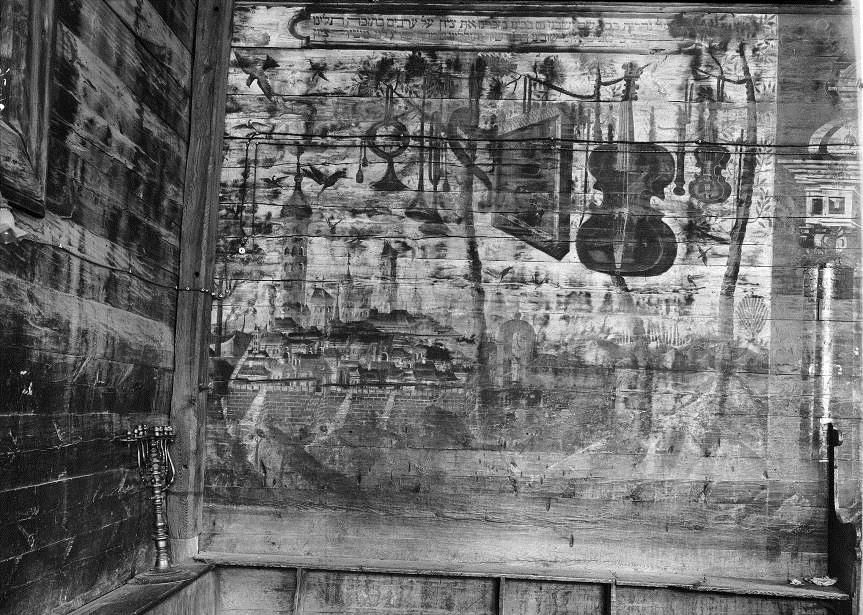
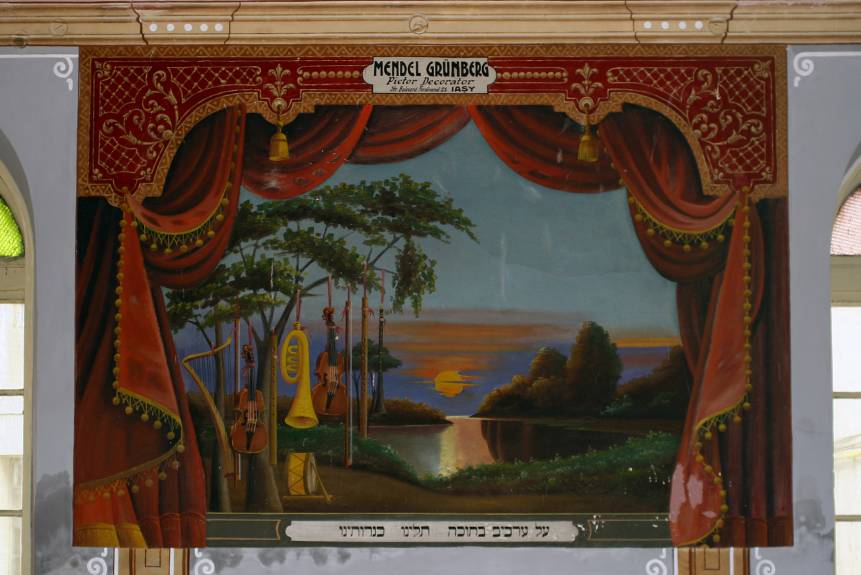
The Grain Merchants’ Synagogue, Bacău.
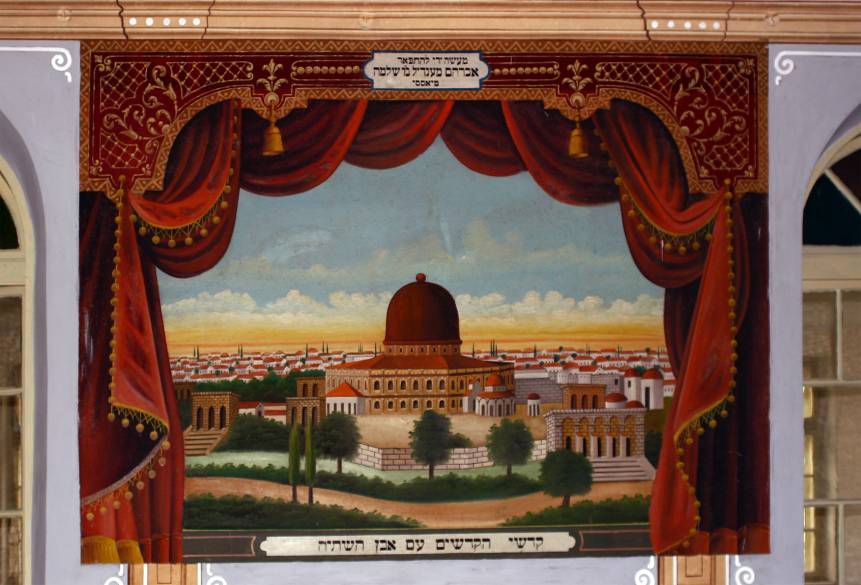
The Grain Merchants’ Synagogue, Bacău.
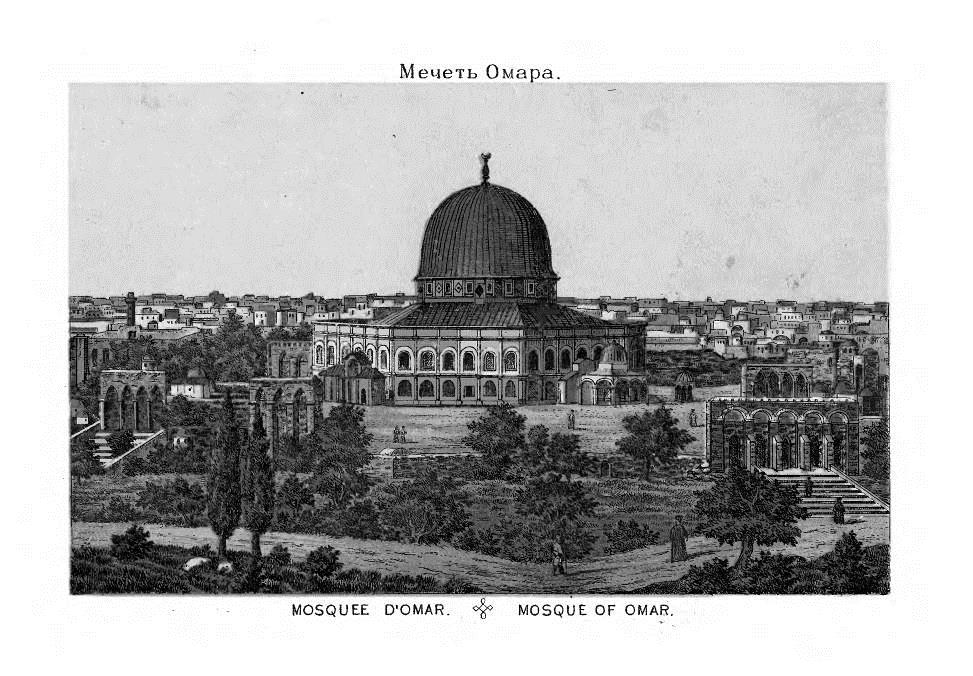
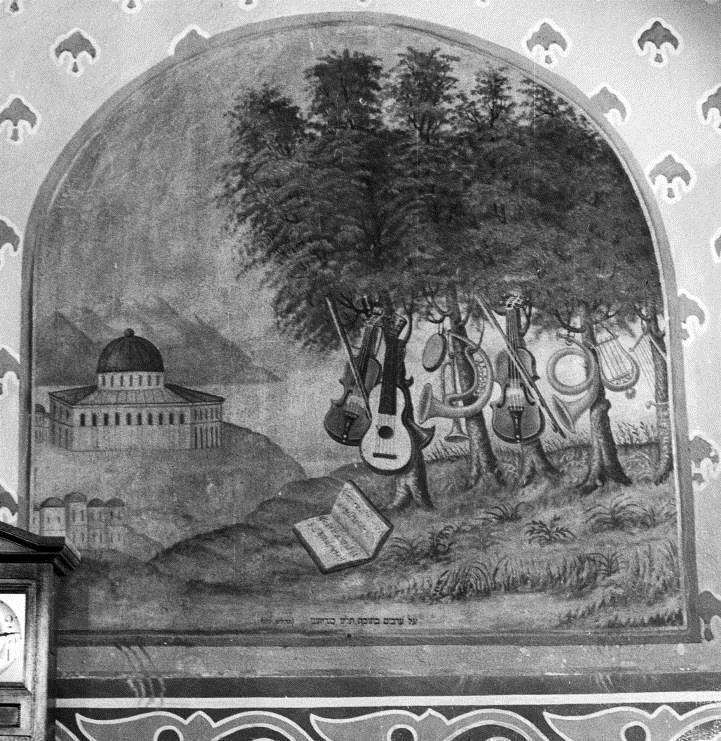
The Center for Jewish Art, the Hebrew University of Jerusalem.
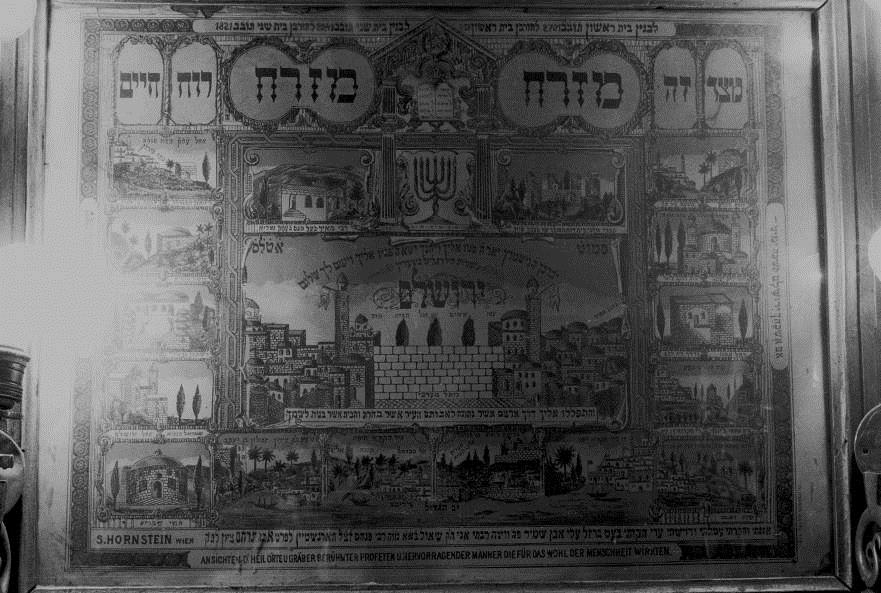
The Center for Jewish Art, the Hebrew University of Jerusalem.
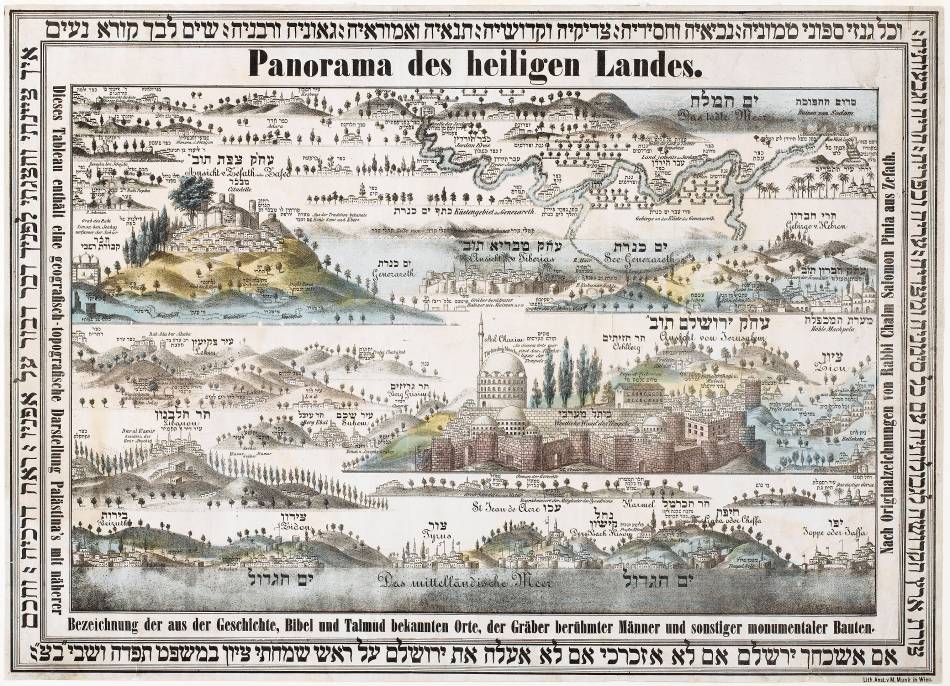
The Gross Family Collection, Tel Aviv.
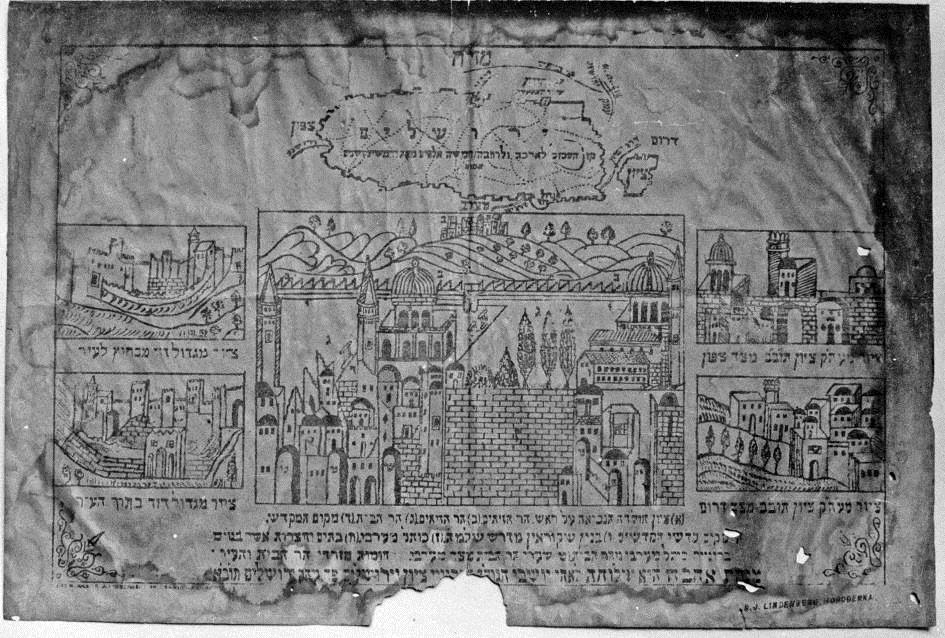
The Center for Jewish Art, the Hebrew University of Jerusalem.
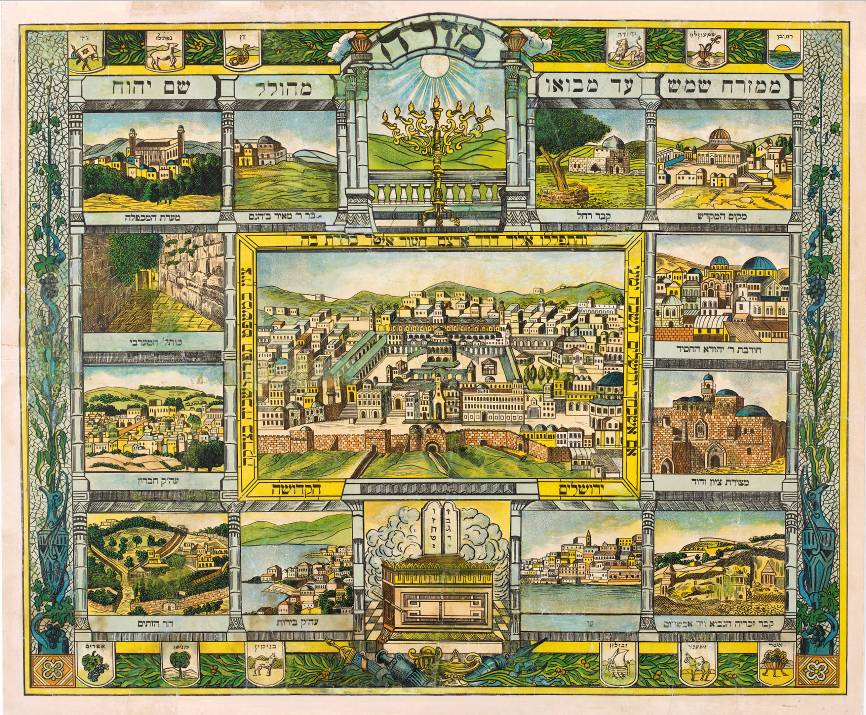
The Gross Family Collection, Tel Aviv.
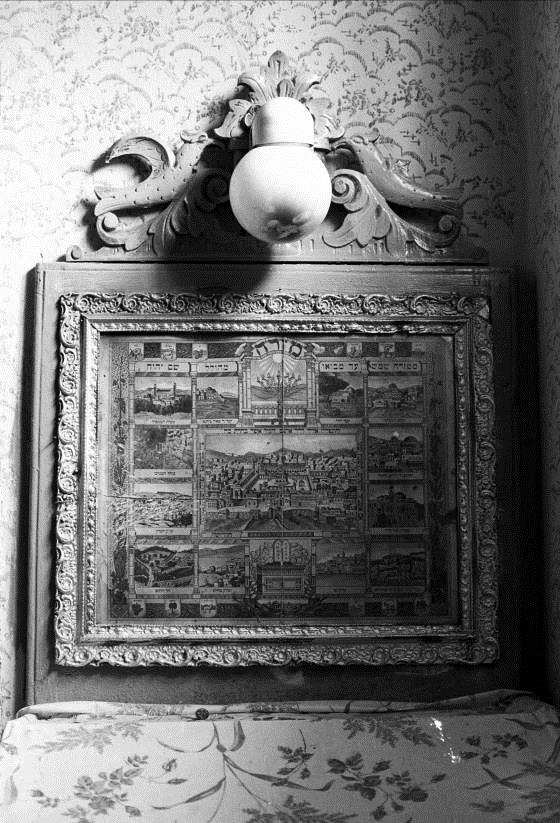
The Center for Jewish Art, the Hebrew University of Jerusalem.
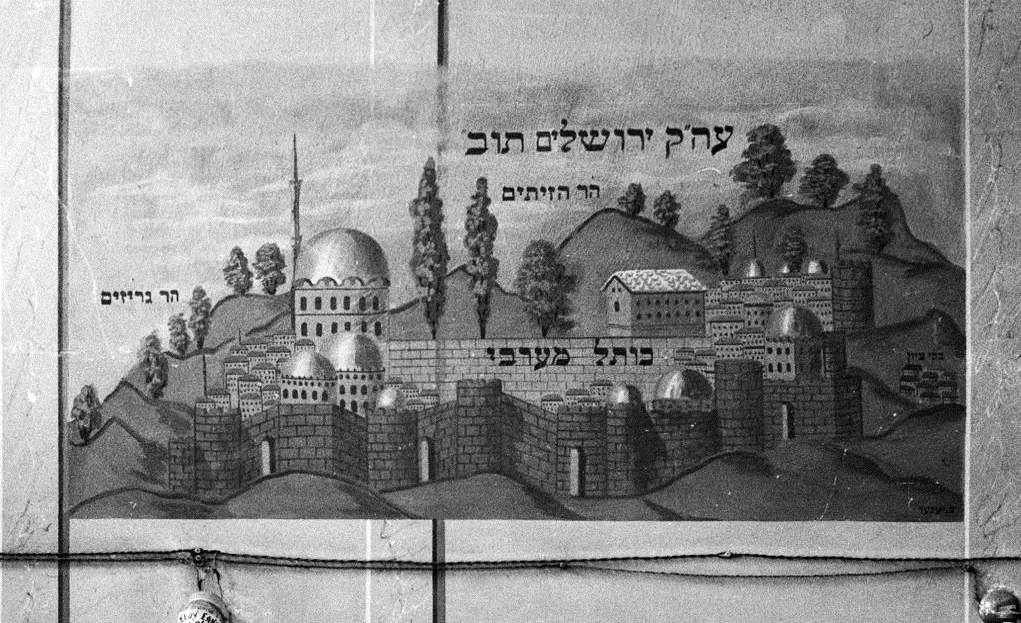
The Center for Jewish Art, the Hebrew University of Jerusalem.
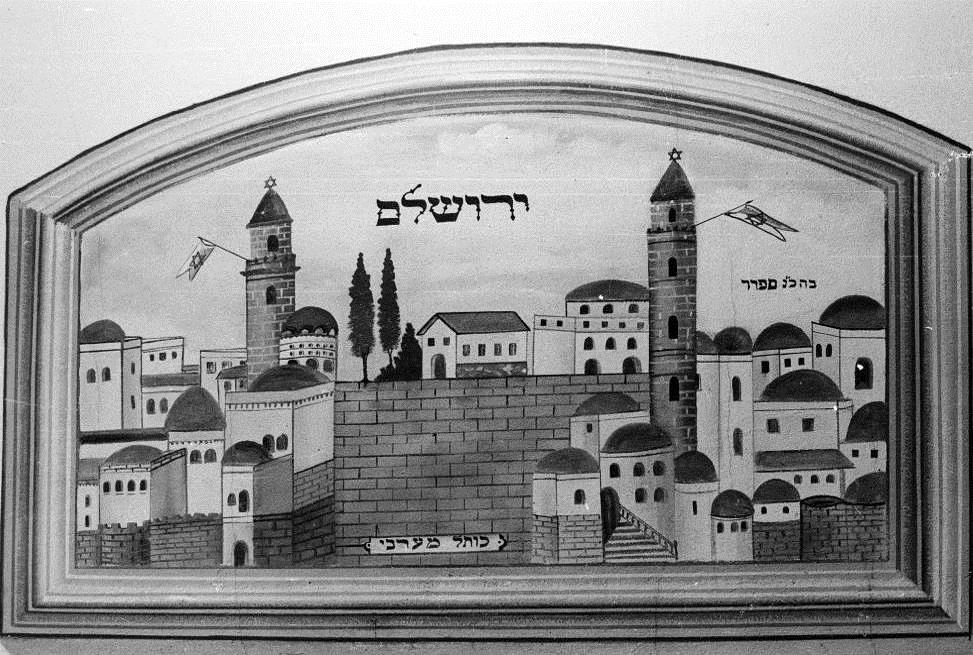
The Center for Jewish Art, the Hebrew University of Jerusalem.
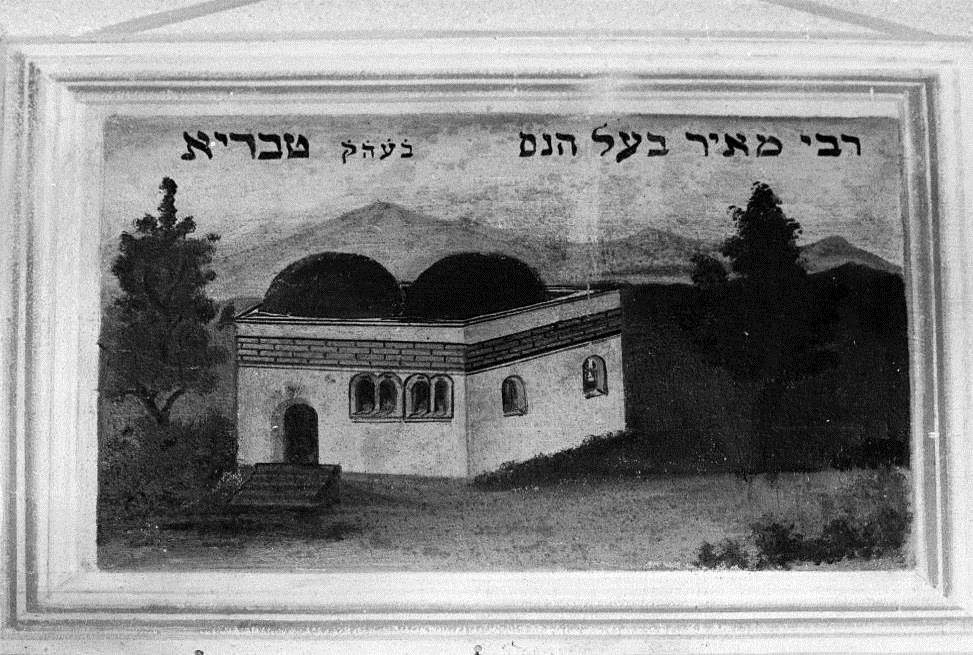
The Center for Jewish Art, the Hebrew University of Jerusalem.
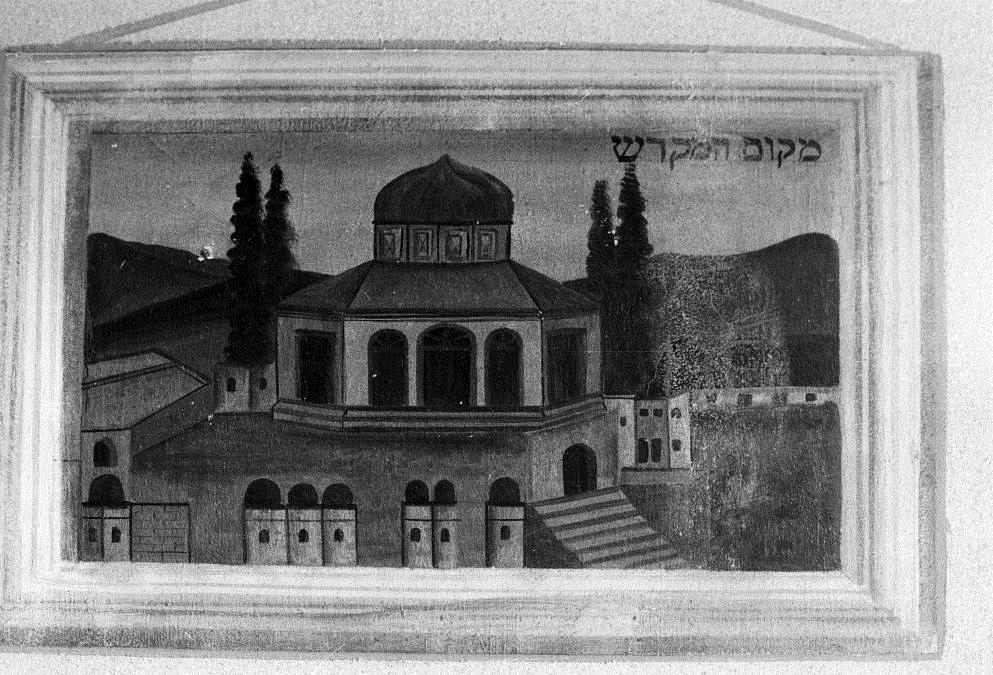
The Center for Jewish Art, the Hebrew University of Jerusalem.
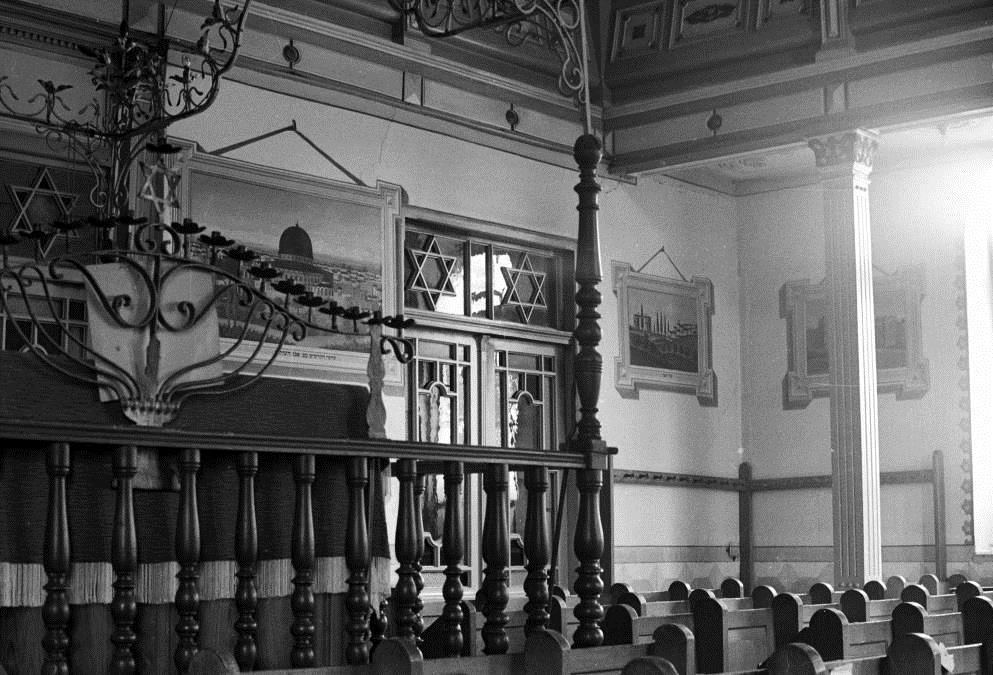
The Center for Jewish Art, the Hebrew University of Jerusalem.
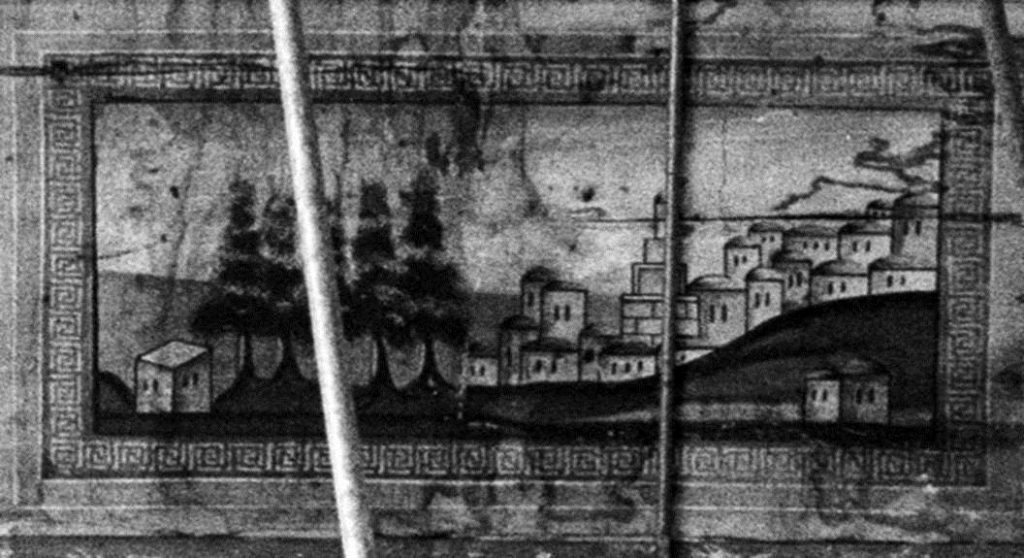
The Center for Jewish Art, the Hebrew University of Jerusalem.
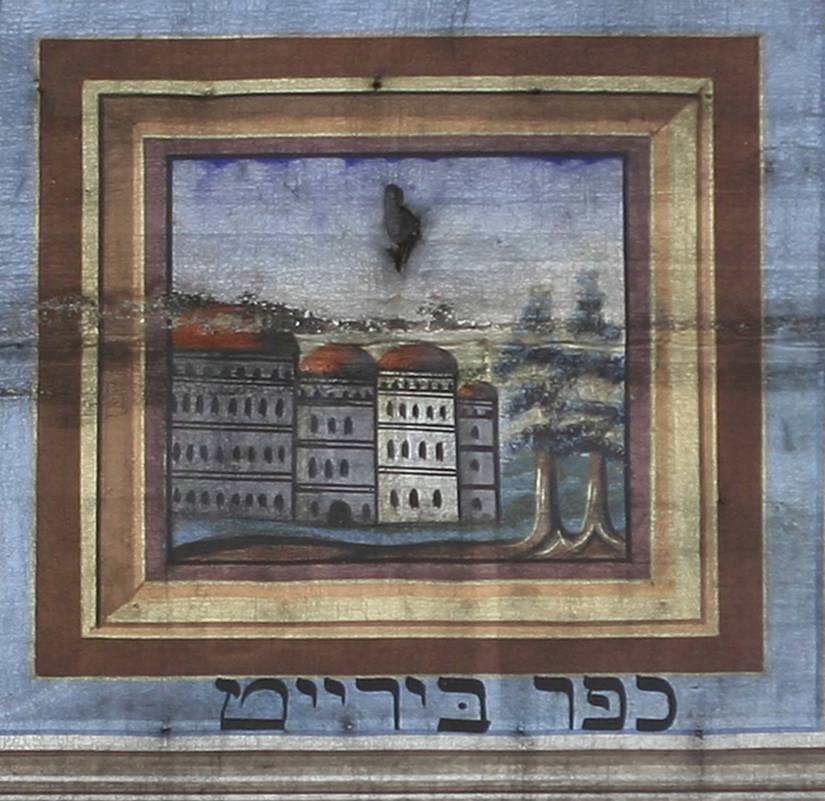
The Great Synagogue, Botoşani.
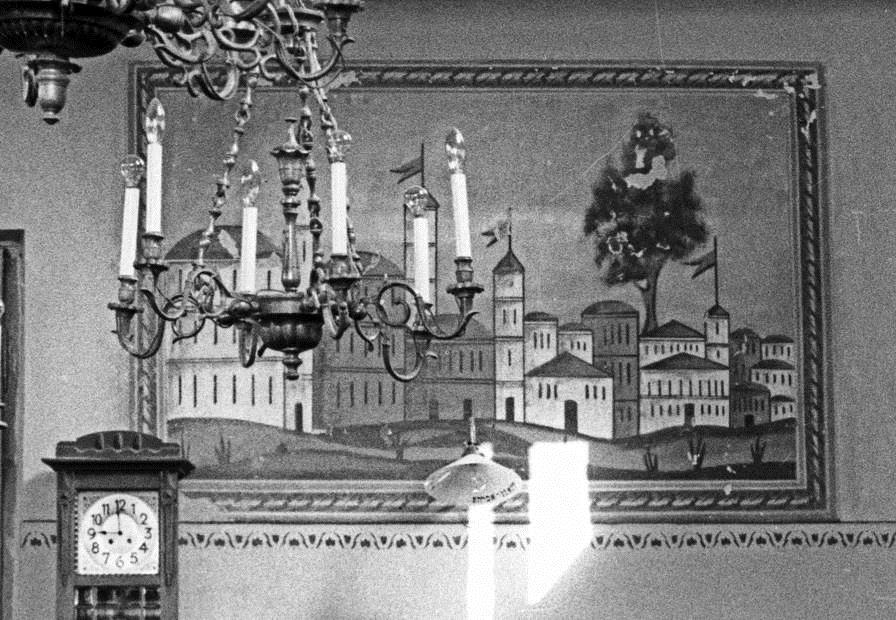
The Center for Jewish Art, the Hebrew University of Jerusalem.
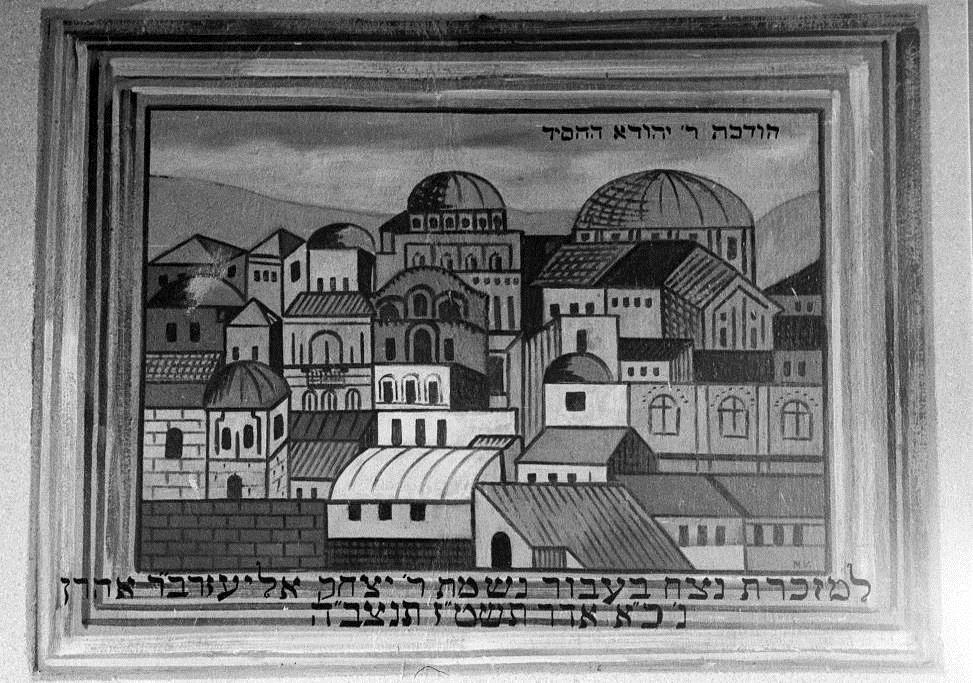
The Center for Jewish Art, the Hebrew University of Jerusalem.
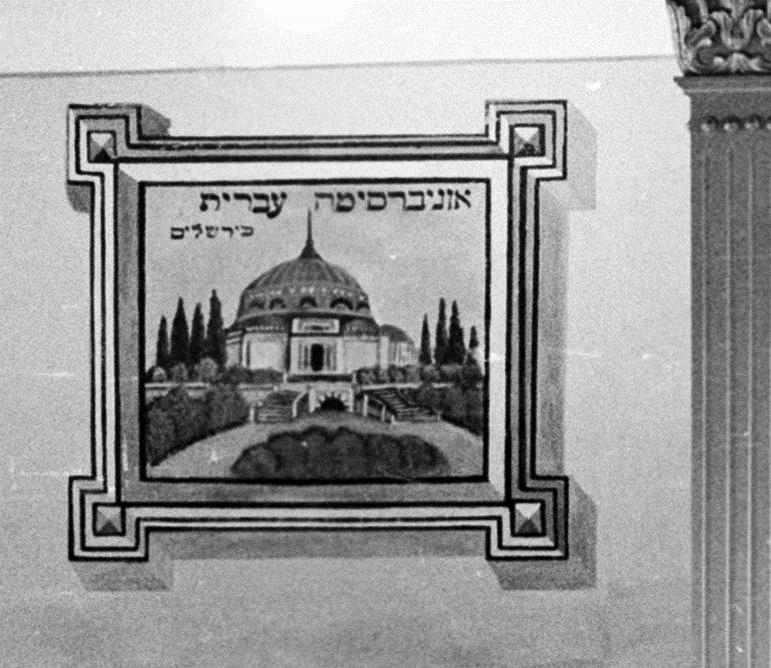
The Center for Jewish Art, the Hebrew University of Jerusalem.
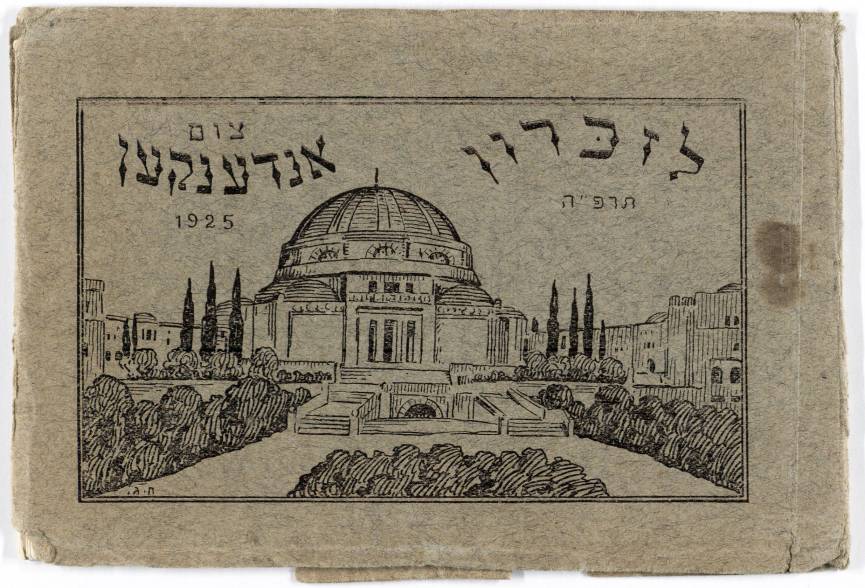
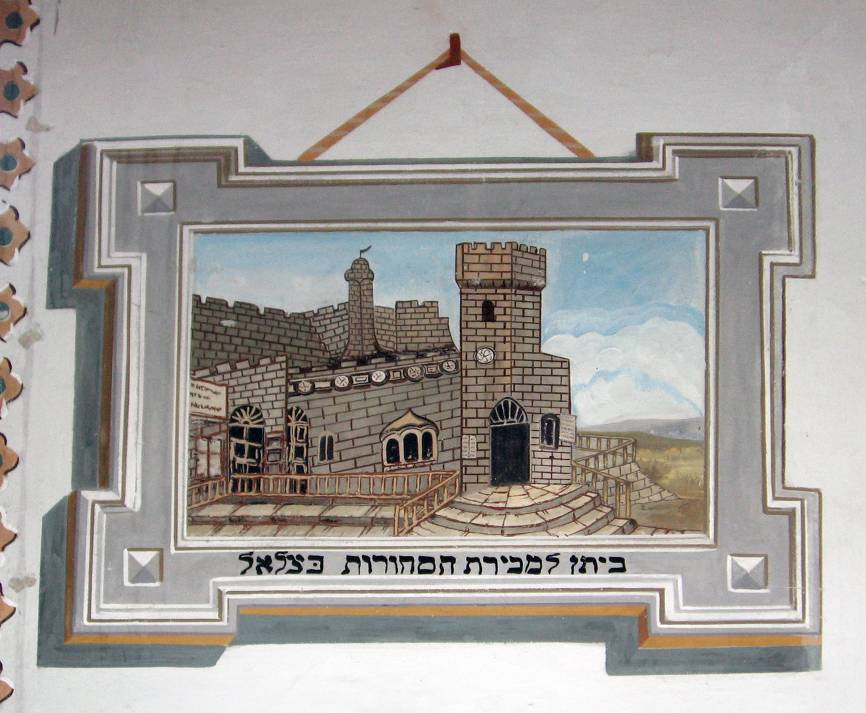
The Leipziger Temple, Piatra Neamţ
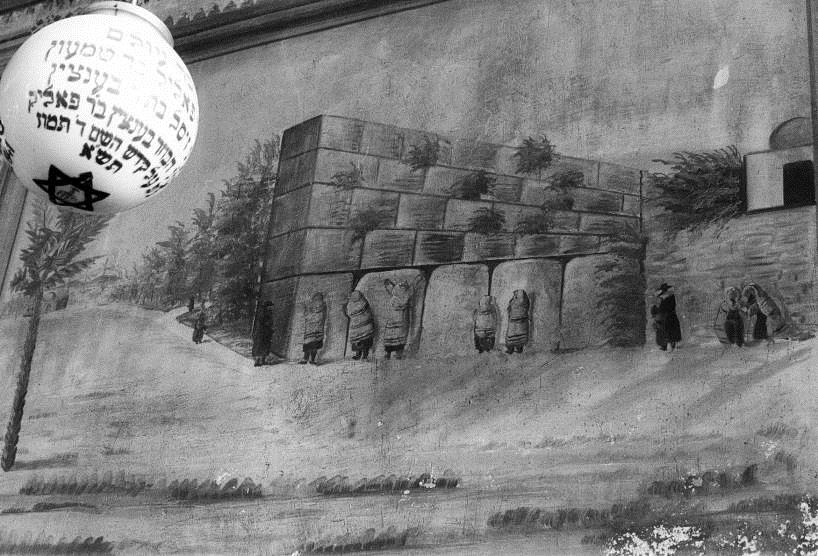
The Center for Jewish Art, the Hebrew University of Jerusalem.
BACK
This research was supported by the Israel Science Foundation (grant No. 265/08)
Ilia Rodov is Head of the Department of Jewish Art at Bar-Ilan University and editor of Ars Judaica - Bar Ilan Journal of Jewish Art. He is the author of The Torah Ark in Renaissance Poland: A Jewish Revival of Classical Antiquity (Leiden and Boston, 2013) and many other works on European synagogue art, focusing on the history, patronage, and meanings of synagogue paintings, sculptures, architectural decoration, and furniture design.
